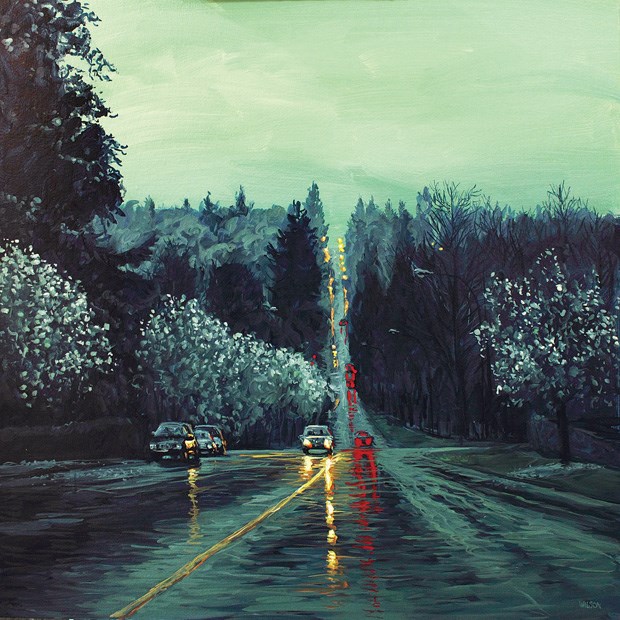David Wilson: New Works at the Winsor Gallery, Nov. 30 - Jan. 11, 2014.
The car veers toward the post-apocalyptic city.
It's a vision of Vancouver shaped by blurred lines, the way the city might look through bloodshot eyes squinting against a spring storm.
David Wilson's exhibition, New Works, has captured the beauty, moodiness and loneliness of Vancouver at night.
It's an exhibition Wilson has risked his health to complete.
"I was supposed to have surgery in October but I asked them to postpone it until December because I needed the time to get ready for my exhibition," he says.
Asked why he insisted on postponing the surgery, Wilson chuckles.
"I've been asking that to myself right now," he says. "Perhaps it's the stubbornness in me as well as enjoying the experience of creating these works and putting them up on the wall," he says. "You only get a shot at this every couple of years. I didn't want to lose an opportunity, so I pushed through it. But there's always a price to pay."
Wilson's brush creates the Burrard Bridge at dawn and a yellow cab lit by lampposts. The neon of downtown turns into a thousand points of blunted light on Granville Street's rain-slicked pavement.
Wilson works on canvas and cardboard. The canvas paintings are rich and detailed portraits of familiar streets and scenes. The work on cardboard is rougher and wilder. The streets are still real but the paintings show them as they might look in a nightmare.
As an artist, Wilson discovered a measure of freedom in cardboard. He'd spent most of his career working with acrylic paint on canvas when he ran out of supplies in his Gastown studio.
"I needed to do a sketch for a painting and I had run out of paper and my supplier is on Granville Island. I had some cardboard lying around so I just pulled it out and nailed it to the wall and started drawing on it," he says.
The cardboard allowed more personal expression while also carrying the marks of the city.
"I've driven by cardboard that sits on the street for days and days and days. People drive overtop of it. It sits in the rain. The stuff just doesn't go away," he says.
"I like the durability of it. It's tough. There's no emotional investment, either. With canvas I have to prepare the canvas David Wilson's Vessels 38 x 62 inches - mixed media on corrugated board. and spend a lot of time working on it getting it ready for painting and with cardboard I pull it out, nail it to the wall."
The cardboard work shows Wilson at his most spontaneous and impressionistic.
"I can insert some of the things that are going on in my life without expressing it overtly. I enjoy that, it's good therapy for me."
The rougher material lends itself to images of a city in ruins, according to Wilson.
"The idea behind the corrugated board is that it's a disposable material and it's kind of in the midst of decay when I'm salvaging it," he says. "Cities, if you leave them without any maintenance they will fall apart. They'll just crumble."
Whether depicting a mass of bright windows stretching to the horizon or headlights drawing halogen circles on a road that splits a pastoral setting, Wilson's canvasses have both clarity and serenity.
"The work on canvas, it satisfies a certain need in my life to explore beauty and the things that surround me and places I've been," he says.
The canvas work often contains an interplay of long shadows and artificial light, similar to the chiaroscuro compositions found in film noir. While the painting may evoke loneliness, Wilson says they are more about being alone.
"As a painter I work in solitude for the most part," he says. "I've worked in public and I just can't do it. I hate it. It's too overwhelming."
Increasingly, Wilson paints at home, usually at night.
"I have time to collect my thoughts through the day and by the time evening rolls around I'm ready to insert some of those thoughts into my work," he says.
While his paintings are inspired by Edward Hopper's New York street scenes, Wilson is conscious of forging his own identity.
"There's always that struggle to be influenced by somebody yet to have your own voice," he says. "It really takes a long time to establish yourself as an artist. If you really want to be an artist you have to be willing to put in the hard years, the hard time."
Before he was a serious artist, Wilson was an incessant doodler.
"As a kid I used to draw all the time. I would draw cartoons of my family which was really funny because they were never very complimentary," he says.
His parents still have a collection of the uncomplimentary drawings, which Wilson calls "a way of taking shots at them without actually taking a physical shot."
Many of the paintings in the exhibition are intensely personal, although Wilson says he's unsure if gallery goers will recognize the acrylic revelations on canvas and cardboard.
While Wilson works in solitude, many of his paintings need to survive inspection from friends and family.
"When they're not good I can tell and my family can tell. 'That's not very good, dad,'" he says, imitating his daughter.
His wife is often the first to view the new paintings.
"Sometimes she's too busy to look at them. She's seen so many of them. It's not that just she's jaded or anything, she says 'Oh, there's another one.' It's like a loaf of bread almost sometimes, it seems."
Wilson repainted four canvasses that are now in the exhibition, each one improving on the last, he says.
"I'm very proud of each piece," he says. "I hope that people will be able to recognize that for one: there's no dogs in the exhibition."



